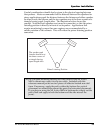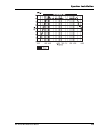
Speaker Installation
20 M1 Active Reference Manual
STEREO NEARFIELD PLACEMENT OF THE
M1 ACTIVE MK2
NOTE: We recommend that the M1 Active Mk2 speakers be placed with the
tweeters to the inside , not the outside, of the listening triangle.
The “classic” studio monitor layout used to be that the tweeters be placed to
the outside of a horizontally-oriented speaker. In the past, this configuration
was actually beneficial in time aligning the tweeter with the woofer if the
cabinets were not toed-in toward the listener. However, this configuration is
highly prone to comb filtering effects if the listener’s head is moved from
side-to-side while mixing. This “comb filtering” causes the mid-to-high
frequency tones to get louder, then softer, then louder again as you move
your head from side-to-side, making it very confusing when trying to mix
with precision.
Some people still believe that stereo separation is “improved” with tweeters
to the outside, but this is advice left over from the early days (the sixties) of
stereo recordings when “correct” stereo often meant a complete hard right or
hard left placement of an instrument (or singer). As stereo mixing techniques
changed toward placing the vocalist (for example) in the center, the old
“tweeters-out” orientation would indeed widen the image if one’s head were
kept in the exact center position. But this set-up proves to be very tiring, very
quickly for the recording engineer. And, to others who are listening to the
mix from either side of the engineer, the sound will seem to be coming
primarily from the speaker closest to them.
Fortunately, recording techniques have changed radically since the sixties.
Engineers have learned to how to “place” an instrument or singer within the
mix so that an accurate re-creation of the actual instrument and vocal
positioning (left-to-right and front-to-back) is achieved. In the M1 Active
Mk2, advances in crossover design technologies and improvements in the off-
axis response of tweeter domes and woofer cone materials and profile have
made the requirement for tweeters to be placed to the outside of the cabinet
obsolete. In fact, using a non-toed-in, tweeters-out orientation with a
modern, wide dispersion design like the M1 Active Mk2 will increase the
likelihood of hearing unwanted first reflections and a variety of phase
anomalies in your mix.


















